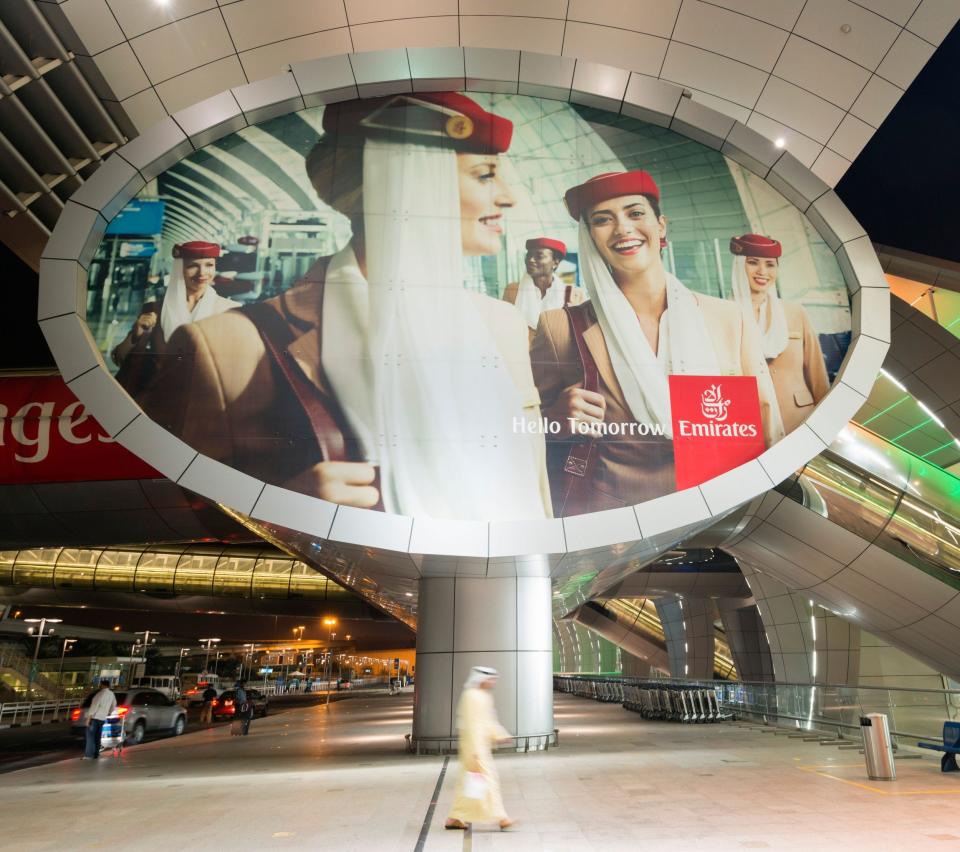The battle to be the Middle East’s ultimate aviation hub

- Oops!Something went wrong.Please try again later.
It was a day that changed the world of travel for good. At exactly 11.45am on October 25 1985 Captain Fazle Ghani Mian pushed forward the throttle on his Airbus A300 and flight EK600 to Karachi raced down the sand-flecked runway at Dubai airport. Emirates airline was born.
Fast forward to today and Emirates and the other shiny new Gulf airlines that have followed in its slipstream have transformed and now dominate global international aviation. Emirates alone is the biggest international airline by passenger miles flown. Qatar Airways is regularly named the world’s best in airline rankings. Etihad is emerging as a boutique Gulf operator, a Virgin Atlantic to Emirates’ or Qatar’s British Airways.
Not only are the carriers big, they are beautiful. Each has introduced innovations that have raised the bar for travellers. Emirates was the first airline to put showers and a large bar with a dining table for four people on its Airbus A380 superjumbo. It is setting new standards in premium economy.
Qatar Airways introduced the Q Suite, a business class suite better than the first class suites on many carriers, and offers the world’s best economy cabin on its A380. Etihad launched The Residence, a private three-room suite with its own shower, living room and lounge for two people, which costs £20,000 one way between London and Abu Dhabi.

And now there’s a fourth major “Gulfie”. Saudi Arabia announced last week it is spending £30bn on a fleet of 72 Boeing 787 “Dreamliner” jets for its new carrier Riyadh Air. The hangar-fresh airline will start flying in 2025 and connect more than 100 destinations around the world by 2030 from a revamped six-runway airport in Riyadh. Saudi’s existing flag carrier, Saudia, will continue but is thought likely to concentrate on the regional Middle Eastern market.
Riyadh Air’s CEO, Tony Douglas, who managed the building of Heathrow Terminal 5 before becoming chief executive of the entire airport and then moved to run Etihad before taking his new role in Riyadh, is too busy signing jet orders and hiring staff to give interviews, but analysts suggest he will adopt a hybrid business model, half way between that of Qatar Airways and Emirates.
Riyadh Air is a key element of Vision 2030, the plan set out by the Saudi ruler Mohammed bin Salman, known as MBS. He has earmarked $1 trillion over the next decade to make the kingdom a global tourist destination attracting tens of millions of visitors a year, after many years of self-imposed isolation. A cruise sector, luxury Red Sea resorts and eco-lodges in the desert are all being created.
“If MBS is going to have any kind of chance of pulling off even half of what he plans, he will need to get millions of people to visit Saudi for the first time, many of whom will have doubts about visiting because of the country’s image,” explains one Gulf-based aviation analyst. “The only way he can do that is by making it as easy and cheap as possible.” With direct air links from major cities to Riyadh limited, “the only answer is a new homegrown airline.”
Observers predict that Riyadh Air passengers will initially be split 50/50 between “transfer traffic” – long-haul passengers using Riyadh as a hub to connect to destinations outside the kingdom – and those travelling to and from the kingdom. But the proportion of direct travellers to and from Saudi will rise as the new resorts and tourist attractions are built and business hubs grow.

One key stumbling block is alcohol, which is banned in Saudi Arabia. But by the time Riyadh Air’s first flight takes off it’s expected that the airline will be licensed to serve alcohol outside Saudi airspace. The airline’s lounges in Saudi Arabia will remain “dry”.
How – and why – has the Gulf come to redefine global aviation? It’s tempting to lump all the new carriers together in a global race for scale but each has a different history and purpose. Emirates was the key plank of the plan by Sheikh Mohammed bin Rashid Al Maktoum, ruler of Dubai, to secure the economic future of an emirate that has little or no oil by turning it into the New York of the Middle East.
The airline’s creation, followed by the construction of an airport capable of handling 120 million passengers a year, was designed to make money. Dubai’s location halfway between Europe and Asia, and halfway between Asia and Africa, is ideal for travellers on the new trade and tourism routes of the modern world. But it was also designed to attract people to visit Dubai and set up homes and businesses there. It has worked spectacularly, fuelling the city state’s break-neck speed growth – its population has skyrocketed from 250,000 in 1980 to almost 4 million today. Small wonder Dubai is nicknamed “a great airport and airline with a city attached”.

Qatar, meanwhile, does not need to become a business, real estate, travel and tourism hub because it is the richest country in the world. Its gas reserves and tiny native population of 350,000 make it the world’s wealthiest country on a per capita basis, with GDP per head of more than £400,000. (The UK figure is £30,000). But it is small and vulnerable to its neighbours, notably Saudi Arabia, which recently imposed an economic blockade. So its emir Tamim bin Hamad Al Thani decided to use aviation to bolster his country’s image and, by extension, clout on the world stage.
Qatar Airways is a flag carrier in the truest sense; the oryx tailfin puts Qatar on the map. The airline and Hamad airport, which can handle up to 55 million passengers a year, has also enabled the emir to host the biggest event in the world, last year’s football world cup. Everybody now knows the country’s name and where it is.
Etihad is a child of politics, too. Abu Dhabi is the federal capital of the United Arab Emirates and its ruling Al Nahyan family bristled at the success of Emirates and Dubai. So, they decided to launch a flag carrier for the country (which was a bit awkward since Emirates had already nabbed the colours of the UAE flag for its tailfin). They settled on a tailfin with desert hues.
Each of the three carriers has had varying degrees of success. Without the oil and gas riches of Abu Dhabi and Qatar, Emirates, led by Briton Sir Tim Clark, who started his working life as a bus conductor in Bognor Regis, has had to pay its way. Its fortunes were dented during the global financial crisis and it was forced to cut back heavily during Covid. But its big bets – it is the largest operator of the A380 with a fleet of 118 – have paid off.

Qatar Airways is bankrolled by al-Thani and has rarely made a profit in its history. This is of little concern to the airline’s hard-charging boss Akbar al Baker who is focused on retaining his airline’s number one status and stealing market share from his rivals. The emir’s deep pockets meant that Qatar Airways continued flying almost as normal throughout the pandemic, carrying freight and tempting new customers.
Etihad teetered on the brink after its former chief executive, James Hogan, embarked on a disastrous expansion strategy to take on Emirates, which included partnerships with such world-beating aviation titans as Alitalia. Douglas charted a new course, trimming the planned 200-strong fleet he inherited when he was appointed in 2017 to just 72 jets and cutting 10,000 jobs. His successor, Antonoaldo Neves, former boss of Portugal’s TAP, is expanding cautiously, announcing a number of new routes from Abu Dhabi, including Lisbon, Copenhagen, Malagasy, Mykonos and Kolkata. He has also re-introduced the A380, mothballed by Douglas, which will begin flying to London in June.
Is there room for a fourth carrier in the Gulf? “Not on purely commercial terms,” says one analyst, “but Riyadh Air is not about making money, at least not at this stage. It’s about changing the image of Saudi Arabia and tempting people to visit, much as Emirates did when it started flying.” Can it work? “It will be hard because Saudi has a PR problem but it has worked for Dubai and Qatar, so never say never.”

